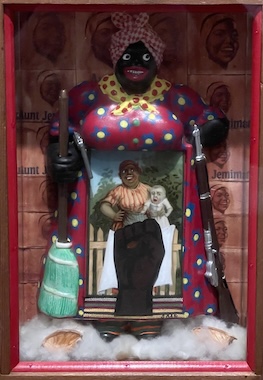Betye Saar facts for kids
Quick facts for kids
Betye Saar
|
|
|---|---|
 |
|
| Born |
Betye Irene Brown
July 30, 1926 Los Angeles, California, U.S.
|
| Nationality | American |
| Education | University of California, Los Angeles, Pasadena City College, California State University, Long Beach |
| Known for | Assemblage |
Betye Irene Saar (born July 30, 1926) is an American artist famous for her unique style of art called assemblage. This means she creates art by putting together different found objects. Think of it like a 3D collage.
Saar is a visual storyteller who also makes prints. During the 1970s, she was an important part of the Black Arts Movement. This was a time when Black artists used their work to explore and challenge ideas about race and being a woman. Throughout her career, Saar has used her art to fight against negative and unfair ideas about African Americans.
Contents
Early Life and Education
Betye Saar was born in Los Angeles, California. After her father passed away when she was five, her family moved to the Watts neighborhood of Los Angeles and later to Pasadena, California.
From a young age, Saar loved to collect small, interesting items. She was always creating things and fixing broken objects. This hobby would later become a big part of her art.
She started her college studies at Pasadena City College and then went to the University of California, Los Angeles (UCLA), where she earned a degree in design in 1947. She continued her studies at several other universities. While in graduate school, she married Richard Saar and had three daughters, two of whom, Alison and Lezley, also became artists.
Artistic Journey
Finding Her Style
Saar first worked as a social worker before following her passion for art. She planned to become a design teacher, but a class in printmaking changed her path. She called printmaking her "segue from design into fine arts."
In 1967, an art show by Joseph Cornell, who also made art from found objects, inspired her to start creating assemblages. She was also fascinated by the Watts Towers, a set of large sculptures in her childhood neighborhood. The artist, Simon Rodia, built them using broken dishes, seashells, and rusty tools. To Saar, these towers were "magical."
She began making art by arranging found objects in boxes or old window frames. These items came from different cultures to show her own mixed background, which includes African American, Irish, and Native American heritage.
Art as a Powerful Statement
In the 1960s, Saar started collecting objects and images that showed racist stereotypes of African Americans. These included figures like Aunt Jemima, Uncle Tom, and Little Black Sambo, which were common in advertising during the Jim Crow era. She used these hurtful images in her art to turn them into powerful statements against racism.
The Liberation of Aunt Jemima
One of her most famous pieces is The Liberation of Aunt Jemima (1972). The character of Aunt Jemima was a mammy, a stereotype of a Black woman who was a happy servant. Saar wanted to change this image. "I wanted to empower her," Saar said. "I wanted to make her a warrior."
The artwork is a small box. Inside, a smiling Aunt Jemima figure holds a broom in one hand, but Saar gave her a rifle in the other. In front of her is a picture of a mammy with a white child, partly covered by a large fist, a symbol of the Black Power movement. By doing this, Saar transformed the character from a racist stereotype into a symbol of power and freedom.
Exploring Heritage and Memory
In the 1970s, Saar's art began to explore African traditions, rituals, and spirituality. After her great-aunt died in 1974, she inherited family keepsakes like old photos, letters, and lockets.
She used these personal items to create shrine-like boxes. These artworks were about memory, loss, and the passing of time. This work showed a more personal and intimate side of her art.
Political Voice in Art

Saar's art has always been connected to social and political issues. In the late 1960s, she became deeply involved in the civil rights movement. She and other Black women artists like Faith Ringgold and Adrian Piper used their art to explore Black identity and fight racism in the art world.
In a 2015 interview, Saar was asked about politics in her art. She said, "I don't know how politics can be avoided... It's not comfortable living in the United States."
In the late 1990s, Saar spoke out about the work of another artist, Kara Walker. Saar felt that Walker's art, which used shocking images of slavery, was reinforcing negative stereotypes. She started a letter-writing campaign to protest an award given to Walker, asking if the art was betraying the memory of enslaved people. This created a major debate in the art world about how to represent Black history.
Major Exhibitions and Honors
Betye Saar's art has been shown in museums all over the world. She has had solo exhibitions at major museums, including:
- Whitney Museum of American Art (1975)
- San Francisco Museum of Modern Art (1977)
- Studio Museum in Harlem (1980)
- Museum of Contemporary Art, Los Angeles (1990)
- The Detroit Institute of Arts (1999)
- Museum of Modern Art, New York (2019)
She has received many awards for her work, including fellowships from the National Endowment for the Arts and the John Simon Guggenheim Memorial Foundation. She has also been awarded several honorary doctorate degrees from prestigious art colleges.
Images for kids
See also
 In Spanish: Betye Saar para niños
In Spanish: Betye Saar para niños



